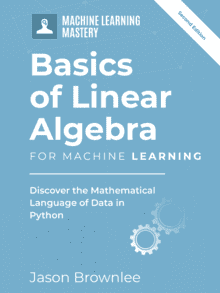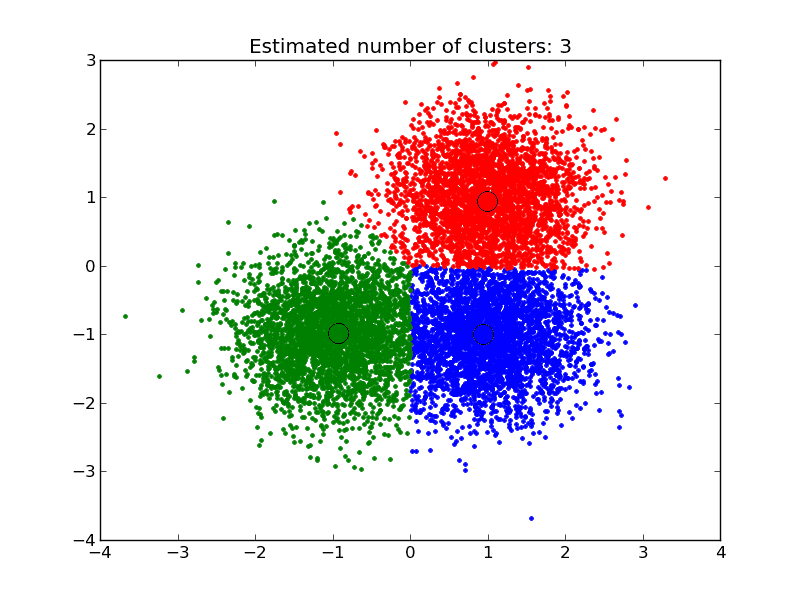Vectors are a foundational element of linear algebra.
Vectors are used throughout the field of machine learning in the description of algorithms and processes such as the target variable (y) when training an algorithm.
In this tutorial, you will discover linear algebra vectors for machine learning.
After completing this tutorial, you will know:
- What a vector is and how to define one in Python with NumPy.
- How to perform vector arithmetic such as addition, subtraction, multiplication and division.
- How to perform additional operations such as dot product and multiplication with a scalar.
Kick-start your project with my new book Linear Algebra for Machine Learning, including step-by-step tutorials and the Python source code files for all examples.
Let’s get started.

A Gentle Introduction to Vectors for Machine Learning
Photo by Lachlan Donald, some rights reserved.
Tutorial Overview
This tutorial is divided into 5 parts; they are:
- What is a Vector?
- Defining a Vector
- Vector Arithmetic
- Vector Dot Product
- Vector-Scalar Multiplication
Need help with Linear Algebra for Machine Learning?
Take my free 7-day email crash course now (with sample code).
Click to sign-up and also get a free PDF Ebook version of the course.
What is a Vector?
A vector is a tuple of one or more values called scalars.
Vectors are built from components, which are ordinary numbers. You can think of a vector as a list of numbers, and vector algebra as operations performed on the numbers in the list.
— Page 69, No Bullshit Guide To Linear Algebra, 2017
Vectors are often represented using a lowercase character such as “v”; for example:
|
1 |
v = (v1, v2, v3) |
Where v1, v2, v3 are scalar values, often real values.
Vectors are also shown using a vertical representation or a column; for example:
|
1 2 3 |
v1 v = ( v2 ) v3 |
It is common to represent the target variable as a vector with the lowercase “y” when describing the training of a machine learning algorithm.
It is common to introduce vectors using a geometric analogy, where a vector represents a point or coordinate in an n-dimensional space, where n is the number of dimensions, such as 2.
The vector can also be thought of as a line from the origin of the vector space with a direction and a magnitude.
These analogies are good as a starting point, but should not be held too tightly as we often consider very high dimensional vectors in machine learning. I find the vector-as-coordinate the most compelling analogy in machine learning.
Now that we know what a vector is, let’s look at how to define a vector in Python.
Defining a Vector
We can represent a vector in Python as a NumPy array.
A NumPy array can be created from a list of numbers. For example, below we define a vector with the length of 3 and the integer values 1, 2 and 3.
|
1 2 3 4 |
# create a vector from numpy import array v = array([1, 2, 3]) print(v) |
The example defines a vector with 3 elements.
Running the example prints the defined vector.
|
1 |
[1 2 3] |
Vector Arithmetic
In this section will demonstrate simple vector-vector arithmetic, where all operations are performed element-wise between two vectors of equal length to result in a new vector with the same length
Vector Addition
Two vectors of equal length can be added together to create a new third vector.
|
1 |
c = a + b |
The new vector has the same length as the other two vectors. Each element of the new vector is calculated as the addition of the elements of the other vectors at the same index; for example:
|
1 |
a + b = (a1 + b1, a2 + b2, a3 + b3) |
Or, put another way:
|
1 2 3 |
c[0] = a[0] + b[0] c[1] = a[1] + b[1] c[2] = a[2] + b[2] |
We can add vectors directly in Python by adding NumPy arrays.
|
1 2 3 4 5 6 7 8 |
# add vectors from numpy import array a = array([1, 2, 3]) print(a) b = array([1, 2, 3]) print(b) c = a + b print(c) |
The example defines two vectors with three elements each, then adds them together.
Running the example first prints the two parent vectors then prints a new vector that is the addition of the two vectors.
|
1 2 3 4 5 |
[1 2 3] [1 2 3] [2 4 6] |
Vector Subtraction
One vector can be subtracted from another vector of equal length to create a new third vector.
|
1 |
c = a - b |
As with addition, the new vector has the same length as the parent vectors and each element of the new vector is calculated as the subtraction of the elements at the same indices.
|
1 |
a - b = (a1 - b1, a2 - b2, a3 - b3) |
Or, put another way:
|
1 2 3 |
c[0] = a[0] - b[0] c[1] = a[1] - b[1] c[2] = a[2] - b[2] |
The NumPy arrays can be directly subtracted in Python.
|
1 2 3 4 5 6 7 8 |
# subtract vectors from numpy import array a = array([1, 2, 3]) print(a) b = array([0.5, 0.5, 0.5]) print(b) c = a - b print(c) |
The example defines two vectors with three elements each, then subtracts the first from the second.
Running the example first prints the two parent vectors then prints the new vector that is the first minus the second.
|
1 2 3 4 5 |
[1 2 3] [ 0.5 0.5 0.5] [ 0.5 1.5 2.5] |
Vector Multiplication
Two vectors of equal length can be multiplied together.
|
1 |
c = a * b |
As with addition and subtraction, this operation is performed element-wise to result in a new vector of the same length.
|
1 |
a * b = (a1 * b1, a2 * b2, a3 * b3) |
or
|
1 |
ab = (a1b1, a2b2, a3b3) |
Or, put another way:
|
1 2 3 |
c[0] = a[0] * b[0] c[1] = a[1] * b[1] c[2] = a[2] * b[2] |
We can perform this operation directly in NumPy.
|
1 2 3 4 5 6 7 8 |
# multiply vectors from numpy import array a = array([1, 2, 3]) print(a) b = array([1, 2, 3]) print(b) c = a * b print(c) |
The example defines two vectors with three elements each, then multiplies the vectors together.
Running the example first prints the two parent vectors, then the new vector is printed.
|
1 2 3 4 5 |
[1 2 3] [1 2 3] [1 4 9] |
Vector Division
Two vectors of equal length can be divided.
|
1 |
c = a / b |
As with other arithmetic operations, this operation is performed element-wise to result in a new vector of the same length.
|
1 |
a / b = (a1 / b1, a2 / b2, a3 / b3) |
or
|
1 |
a / b = (a1b1, a2b2, a3b3) |
Or, put another way:
|
1 2 3 |
c[0] = a[0] / b[0] c[1] = a[1] / b[1] c[2] = a[2] / b[2] |
We can perform this operation directly in NumPy.
|
1 2 3 4 5 6 7 8 |
# divide vectors from numpy import array a = array([1, 2, 3]) print(a) b = array([1, 2, 3]) print(b) c = a / b print(c) |
The example defines two vectors with three elements each, then divides the first by the second.
Running the example first prints the two parent vectors, followed by the result of the vector division.
|
1 2 3 4 5 |
[1 2 3] [1 2 3] [ 1. 1. 1.] |
Vector Dot Product
We can calculate the sum of the multiplied elements of two vectors of the same length to give a scalar.
This is called the dot product, named because of the dot operator used when describing the operation.
The dot product is the key tool for calculating vector projections, vector decompositions, and determining orthogonality. The name dot product comes from the symbol used to denote it.
— Page 110, No Bullshit Guide To Linear Algebra, 2017
|
1 |
c = a . b |
The operation can be used in machine learning to calculate the weighted sum of a vector.
The dot product is calculated as follows:
|
1 |
a . b = (a1 * b1 + a2 * b2 + a3 * b3) |
or
|
1 |
a . b = (a1b1 + a2b2 + a3b3) |
We can calculate the dot product between two vectors in Python using the dot() function on a NumPy array. It can also be calculated using the newer @ operator, since Python version 3.5. The example below demonstrates both methods.
|
1 2 3 4 5 6 7 8 9 10 |
# dot product vectors from numpy import array a = array([1, 2, 3]) print(a) b = array([1, 2, 3]) print(b) c = a.dot(b) print(c) d = a @ b print(d) |
The example defines two vectors with three elements each, then calculates the dot product.
Running the example first prints the two parent vectors, then the scalar dot product.
|
1 2 3 4 5 6 7 |
[1 2 3] [1 2 3] 14 14 |
Vector-Scalar Multiplication
A vector can be multiplied by a scalar, in effect scaling the magnitude of the vector.
To keep notation simple, we will use lowercase “s” to represent the scalar value.
|
1 |
c = s * v |
or
|
1 |
c = sv |
The multiplication is performed on each element of the vector to result in a new scaled vector of the same length.
|
1 |
s * v = (s * v1, s * v2, s * v3) |
Or, put another way:
|
1 2 3 |
c[0] = a[0] * s c[1] = a[1] * s c[2] = a[2] * s |
We can perform this operation directly with the NumPy array.
|
1 2 3 4 5 6 7 8 |
# vector-scalar multiplication from numpy import array a = array([1, 2, 3]) print(a) s = 0.5 print(s) c = s * a print(c) |
The example first defines the vector and the scalar then multiplies the vector by the scalar.
Running the example first prints the parent vector, then scalar, and then the result of multiplying the two together.
|
1 2 3 4 5 |
[1 2 3] 0.5 [ 0.5 1. 1.5] |
Similarly, vector-scalar addition, subtraction, and division can be performed in the same way.
Extensions
This section lists some ideas for extending the tutorial that you may wish to explore.
- Create 5 examples using each operation using your own data.
- Implement each vector operation manually for vectors defined as lists.
- Search machine learning papers and find 1 example of each operation being used.
If you explore any of these extensions, I’d love to know.
Further Reading
This section provides more resources on the topic if you are looking to go deeper.
Books
- Section 1.15, Vectors. No Bullshit Guide To Linear Algebra, 2017.
- Section 2.2, Vector operations. No Bullshit Guide To Linear Algebra, 2017.
- Introduction to Linear Algebra, 2016.
- Chapter 2, Linear Algebra, Deep Learning, 2016.
API
Articles
Summary
In this tutorial, you discovered linear algebra vectors for machine learning.
Specifically, you learned:
- What a vector is and how to define one in Python with NumPy.
- How to perform vector arithmetic such as addition, subtraction, multiplication and division.
- How to perform additional operations such as dot product and multiplication with a scalar.
Do you have any questions?
Ask your questions in the comments below and I will do my best to answer.








So how do you determine a vector to help in classification?
What do you mean exactly Edward?
When you have a feature vector and asked to determine the vector, what does that mean?
If you have a feature vector, it can be classified with a model.
A feature vector is just a row where each value is measurement for a different feature or column.
Does that help?
what is vector addition mean in machine learning?
I have two vector contain features, can I use vector add to preserve two features into single vector?
Adding two vectors together.
Typically we do not add features together unless it has a specific meaning in the domain, e.g. both are coordinates in some larger n-dimensional space.
We can explore an embedding using vector arithmetic or a GAN latent space.
Have you worked with vectors for data for the SageMaker? my data is in numpy arrays but the error msg i get is labels must be a Vector..
I have not used SageMaker, sorry.
Very clear, thanks!
Thanks, I’m glad it helped.
thanks
Jason Brownlee great explaination.
You’re welcome Aminzai.
hi, as far as I know for text classification we need some features and it is up to us to vectorized each sentences based on the specific teacher yes??
I mean we should write suitable program to convert each sentence as vector based on our feature yes?
##i corrected my question sir
hi, as far as I know for text classification we need some features and it is up to us to vectorized each sentences based on the specific feature yes??
I mean we should write suitable program to convert each sentence as vector based on our feature yes?
for feature 1 we should write a program to represent our sentences as a vector while for feature 2 we should consider another pieces of code to represent our sentences as a vector yea?
You can use a bag of words model:
https://machinelearningmastery.com/gentle-introduction-bag-words-model/
I had been looking for similar tutorials for a long time and now I have found. Thank you sincerely.
Thanks!
Just like the way we have a feature vector, can we also possibly have a response vector in here? if yes then what it would consist of sir?
Yes.
You can define the composition of the feature vectors and target vectors for your project.
I know squat about Liner Algebra and this made total sense to me. Thanks for a simple, clear and concise explanation.
You’re welcome.
Explanation was awesome!! its easy to understand.
Thanks!
Great explanation. Thank you!
Thanks!
My code for vector arithmetic operations with lists. I know it’s not perfect.
I forgot to add:
after import modules you should add line:
Vector = List[float]
I added it for you.
Well done, thanks for sharing!
What is the intuition behind applying dot product on 2 vectors? For instance, why do we apply the dot product on the item vector and user vector in content-based filtering (recommender system)
Hi Maanas…The following would be a great place to clarify your understanding:
https://machinelearningmastery.com/linear-algebra-machine-learning-7-day-mini-course/
Hi.Could you explain the concept of reference vectors? I see that mentioned in Kohonen Self-Organizing maps, I cannot understand it.
Hi Guillermo…The following is great starting point regarding vectors and their role in machine learning.
https://neptune.ai/blog/understanding-vectors-from-a-machine-learning-perspective